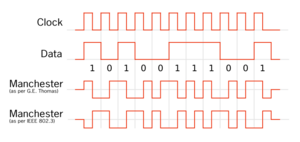Manchester code facts for kids
The Manchester code is a special way to send binary information (like 0s and 1s) that also includes a "clock signal." Think of a clock signal as a steady beat that helps devices understand when to read the information. This is super useful because it means you don't need a separate clock wire. The information is sent by changing the signal's phase, which is a bit like shifting its timing. This method is a type of Phase shift keying, often called PSK.
Simply put, the important information is found when the signal changes, like when it goes from high to low or low to high. Manchester codes are used a lot in technology, for example, in Ethernet networks (which connect computers) and for RFID tags (like those used in store security or for tracking items).
How Manchester Code Works
There are two main ways to understand how Manchester code represents 0s and 1s:
- Original Method: In this way, first defined by G.E. Thomas, a signal that goes from high to low (a "falling flank") means a logical 1. A signal that goes from low to high (an "ascending flank") means a logical 0.
- Ethernet Method: The original Ethernet standard uses the opposite. Here, a falling signal flank means a logical 0, and an ascending signal flank means a logical 1.
To make sure there's no confusion about which method is being used, Manchester codes often start with a "preamble." A preamble is a special, known sequence of bits that tells the receiving device how to interpret the rest of the signal.
Why Use Manchester Code?
Manchester code has some cool benefits and a few downsides:
- No DC Component: One big advantage is that the signal doesn't carry any "DC component." This means it doesn't have a constant electrical charge that could build up. This is good because it allows information to be sent over cables that aren't usually designed to carry power, like some network cables.
- Built-in Clock: As mentioned, the clock signal is part of the data itself. This makes it easier to synchronize devices and reduces the number of wires needed.
However, there's a trade-off:
- More Bandwidth Needed: Manchester code needs more bandwidth than some other ways of encoding data, like NRZ. Bandwidth is like the size of the "pipe" for data; more bandwidth means you need a bigger pipe to send the same amount of information.
See also
 In Spanish: Codificación Manchester para niños
In Spanish: Codificación Manchester para niños


